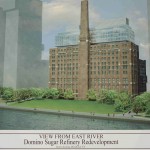Preservation and housing advocates squared off over development plan. On February 5, 2008, Landmarks held a public hearing regarding alterations and additions to the Domino Sugar Refinery complex, located in the Williamsburg section of Brooklyn.
In 2007, the City designated three buildings at the complex. 4 CityLand 141 (Oct. 15, 2007). During the designation process, the owner of the property, Community Preservation Corporation, warned Landmarks that the buildings’ infrastructure would need extensive retrofitting in order to accommodate residential use. 4 CityLand 93 (July 15, 2007).
At the most recent hearing, the owner unveiled the designs for the complex, which include a five-story glass rooftop addition to the 124year-old refinery building, five 40story towers, and a waterfront esplanade. The total development would yield 2,200 residential units, 120,000 sq.ft. of retail space, 100,000 sq.ft. of community facility space, 1,500 parking spaces, and several acres of publicly accessible open space. Fred Bland of Beyer Blinder Belle, one of Community Preservation’s architects, characterized the project as a “21st century completion” of the buildings.
Community Preservation CEO Michael Lappin testified that the buildings’ current condition is the result of being “repeatedly ravaged by their industrial stewards,” and, therefore, required major alterations. Lappin stressed, however, that the alterations would “respect and pay homage” to the buildings’ “previous incarnation.” Lappin also stated that the redevelopment would create affordable housing units, amounting to 30 percent of the planned units, allow pedestrian access to the Brooklyn waterfront, and create hundreds of new jobs.
Community Preservation’s engineer, Robert Silman, echoed Lappin’s arguments, calling the refinery building “a structural mess.” Silman called Landmarks’ attention to the refinery building’s cast-iron columns and beams, which he claimed cannot support residential use. Indeed, according to Silman, the only part of the building suitable for reuse is its envelope.
Housing advocates and some community members supported the proposal. Father Jim O’Shea, Director of Churches United, stated that the purpose of preservation should be to teach a lesson to future generations. Allowing the alterations would show future generations “we created homes for 660 families.” Community resident Robert Solano testified that the complex had employed many people in the area before closing after a five-year strike. The redevelopment would, Solano argued, build affordable housing and make for a better history for the complex.
Preservationist groups, however, largely opposed the alterations. Lisa Kersavage of the Municipal Art Society testified that “the proposed addition is inappropriate and needs to be entirely rethought,” while similar sentiments were expressed by the Historic Districts Council and the Society for the Architecture of the City.
Commissioner Christopher Moore stated his belief that “preservation and affordable housing can be compatible.” Commissioner Stephen Byrns, meanwhile, said that the owner had a “good proposal” overall, but found the proposed development too large and too tall. The hearing was then closed without a vote.
LPC: Domino Sugar Refinery, 292 Kent Ave., Brooklyn (COFA# 08-4774) (Feb. 5, 2008).
CITYLAND Comment: On March 4, 2008, Landmarks asked Community Preservation to amend its proposal.


